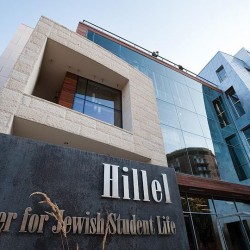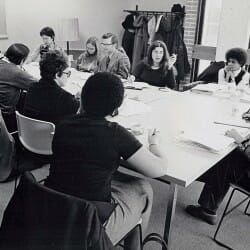The Rise and Fall of the Kiekhofer Wall
Before social media, UW students shared messages via Langdon Street graffiti.

Cadets in the U.S. Navy’s V-12 training program loiter by the Kiekhofer Wall in the 1940s. UW Archives S05452
Sometimes the word on the street isn’t so much on the street as adjacent to it. From the 1880s to the 1940s, the UW’s equivalent of social media was an eight-foot-high, 120-foot-long brick wall along Langdon Street: Kiekhofer Wall.
The wall took its name from William “Wild Bill” Kiekhofer, a professor of economics who taught Econ 1a, one of the most popular lectures on campus. Kiekhofer didn’t own the wall or the estate it bordered, though his father-in-law (Professor Edward Owen) did. Because of its proximity to fraternity and sorority houses, the wall was frequently decorated with graffiti. For decades, the Kiekhofer Wall offered a grand-scale message board on which to announce parties, political opinions, and romantic intentions. From the 1920s to the 1940s, it was a Homecoming tradition for the UW’s Cardinal Key society — an honorary student group — to paint the wall to match that year’s theme. The photo above shows two members of the UW’s V-12 program — which trained officer cadets for the navy and Marine Corps during World War II — posing with dates.
The wall didn’t long outlast the cadets, however. In the summer of 1946, the wall came down to make way for construction of the UW’s Hillel Foundation, which today stands on the site of the Owen estate. Members of some UW sororities swung sledgehammers to deliver the first ceremonial blows to a wall that bore the final graffito, “Bon Voyage, Poor Wall.”
This was not the end of wall-based messaging on campus. In the 1960s, the long, slow construction of the Humanities Building gave the UW a new semipermanent surface for personal expression, as a fence around the site was frequently decorated by campus denizens. Today’s students carry on the tradition with sidewalk chalk.
Published in the Summer 2021 issue



Comments
No comments posted yet.